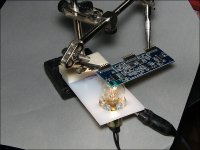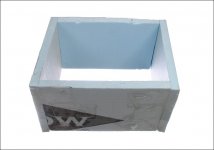I don’t own a hot air station .
Wondering what the best way is to remove driver ic’s without a hot air station ?
I don’t wanna damage the board or traces since I can’t just heat up the legs and remove it .
The back tab of the driver ic’s solder to the board .
Any ideas ?
Here is a pic of a new driver ic showing the back
Wondering what the best way is to remove driver ic’s without a hot air station ?
I don’t wanna damage the board or traces since I can’t just heat up the legs and remove it .
The back tab of the driver ic’s solder to the board .
Any ideas ?
Here is a pic of a new driver ic showing the back
Attachments
You can make a simple holder for an 1157 lamp and use that to apply heat from the bottom. Make a support for the board to hold it. Below is a simple example (insulating board and packing tape).
The 1157 can get so hot that it can damage the board so, initially, hold it off of the board by about 1/4". Move it closer if you need more heat. inserting a limiting resistor, using a combination of the filaments or using a variable 12v power supply can help adjust the temperature.
Applying flux to the board can help you gauge how hot the board is (flux soldering, flux boiling, flux burning off quickly).
If you have a junk board, test with that, including using flux and solder to get an understanding of what you will have on the amp you're working on.
Apply a bit of solder to the board so the new IC won't quite lay lay down, then, when it's hot, the IC will drop onto the board.
If you're not sure that the IC will readily take solder, tin the bottom of it at a relatively low temperature like 600F.
The 1157 can get so hot that it can damage the board so, initially, hold it off of the board by about 1/4". Move it closer if you need more heat. inserting a limiting resistor, using a combination of the filaments or using a variable 12v power supply can help adjust the temperature.
Applying flux to the board can help you gauge how hot the board is (flux soldering, flux boiling, flux burning off quickly).
If you have a junk board, test with that, including using flux and solder to get an understanding of what you will have on the amp you're working on.
Apply a bit of solder to the board so the new IC won't quite lay lay down, then, when it's hot, the IC will drop onto the board.
If you're not sure that the IC will readily take solder, tin the bottom of it at a relatively low temperature like 600F.


